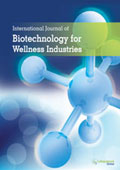ijbwi
Abstract : High Concentration Phenol Removal Using Freshwater Microalgae
|
|
Abstract: The ability of three freshwater microalgae strains, namely Chlaorella sp., Pseudochlorococcum sp. and Chlamydomonas sp. to grow in water containing different concentrations of phenol has been tested. The effectiveness of the selected strains to utilize the phenol as a carbon source and reduce its concentration has also been assessed. The phenol removal efficiency and cells growth rates were evaluated at different initial phenol concentrations, in the range of 100-450 ppm. It was found that growing, under a reduced illumination condition, increased the inhibition onset concentration, enhanced the phenol removal and allowed the strains to tolerate higher phenol concentrations reaching 450 ppm. In the tested range of the phenol concentrations, Chlamydomonas sp. has shown to have the highest specific growth rate of 0.59 day-1, whereas Pseudochlorococcum sp showed the highest phenol removal rate of 166 ppm day-1. Three kinetics models that incorporate substrate inhibition were tested to describe the growth, which show almost identical fittings. Keywords: Microalgae, Phenol bioremediation, Wastewater treatment, Growth kinetics, Substrate Inhibition, Light limitation.Download Full Article |
Abstract : The Cell Regulation Mechanism of Neurovascular Unit
|
|
Abstract: Ischemic cerebrovascular disease is one of the three deadly diseases. It is characterised by high mortality and high morbidity. Because of no effective treatments of recombinant tissue plasminogen activator (rt-PA) and neuroprotectant, there are more and more research focus on neurovascular unit (NVU), which is composed of brain microvascular endothelial cells (BMECs), neuron, astrocyte(AS) and so on. Cell–cell signaling and coupling between these different compartments form the basis for normal function and repair of brain injury. In this mini-review, we will describe the relationship of CMECs, neuron and AS. Keywords: Neurovascular unit, Brain microvascular endothelial cells, Neuron, astrocyte.Download Full Article |
Abstract : Induced Resistance to Ustilago maydis in Zea mays Inoculated in Non-Sterile Conditions
|
|
Abstract: Plants are able to acquire induced resistance to pathogens (priming) by its previous exposure to biotic or abiotic stresses. To analyze whether this process is involved in the maize infection by Ustilago maydis, we have compared the infection occurring in plants inoculated under axenic conditions or in sterile soil to plants grown in non-sterile soil. Our results showed that plants grown under axenic conditions were more susceptible to infection than those inoculated in non-sterile soil. Accordingly, disease symptoms: chlorosis development, anthocyanin production, tumor development, and necrosis, were more and severe in axenic plants. In addition, cell death and reactive oxygen species production, as well as ethylene, were higher in axenic plants. These observations indicate for the first time, that different physical stressors and contact with microorganisms of the environment are responsible for the induction of resistance (priming) in this pathosystem. Keywords: Ustilago maydis, Zea mays, Biotic and abiotic stresses, induced resistance, Priming effect.Download Full Article |
Abstract : Production of Bioagent for Calcium-Based Biocement
|
|
Abstract: Biocements and biogrouts are developing extensively as new materials alternative to cement and toxic chemical grouts. The most popular type of biocement is a mixture of urease-producing bacteria, urea and calcium salt. Thus, development of biotechnology to produce biomass of urease-active bacteria for large-scale biocementation is an important biotechnological task. Two strains of urease-producing bacteria, Yaniella sp. VS8 and Bacillus sp. VS1 that synthesized inducible and constitutive urease, respectively, were used in the present study. It was shown that low cost biomass of urease-active bacteria can be produced from the hydrolyzed excessive activated sludge of municipal wastewater treatment plant. The biomass of Yaniella sp. VS8 grown in this medium diminished the hydraulic conductivity of sand from 4.8×10-4 m/s to 5∙10-8 m/s after severalbiotreatments with solution of 1.5 M urea and 0.75M СаCl2. Keywords: Bacillus sp., Yaniella sp., Activated sludge, Biocement, Biogrout.Download Full Article |























